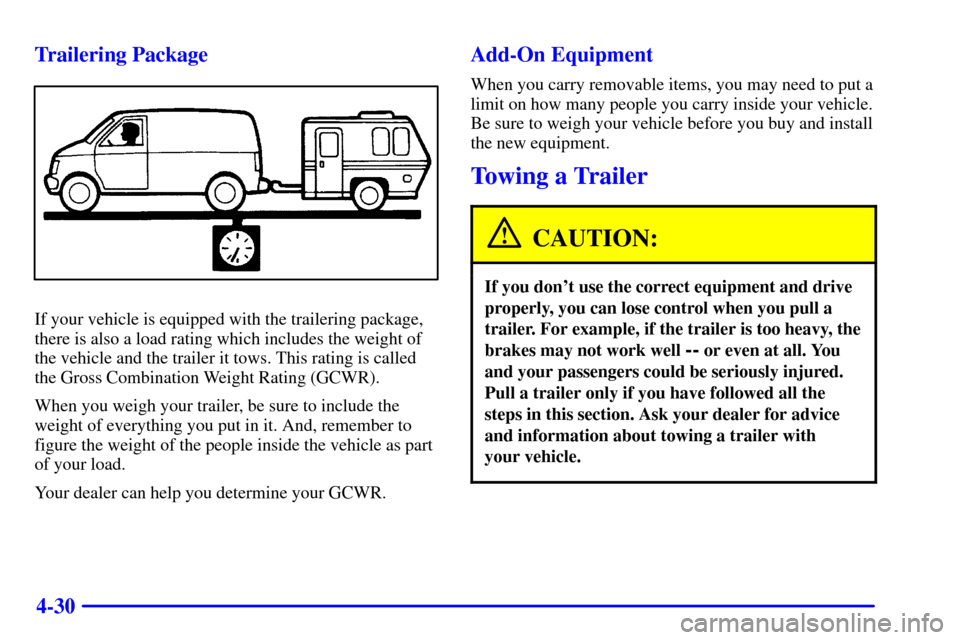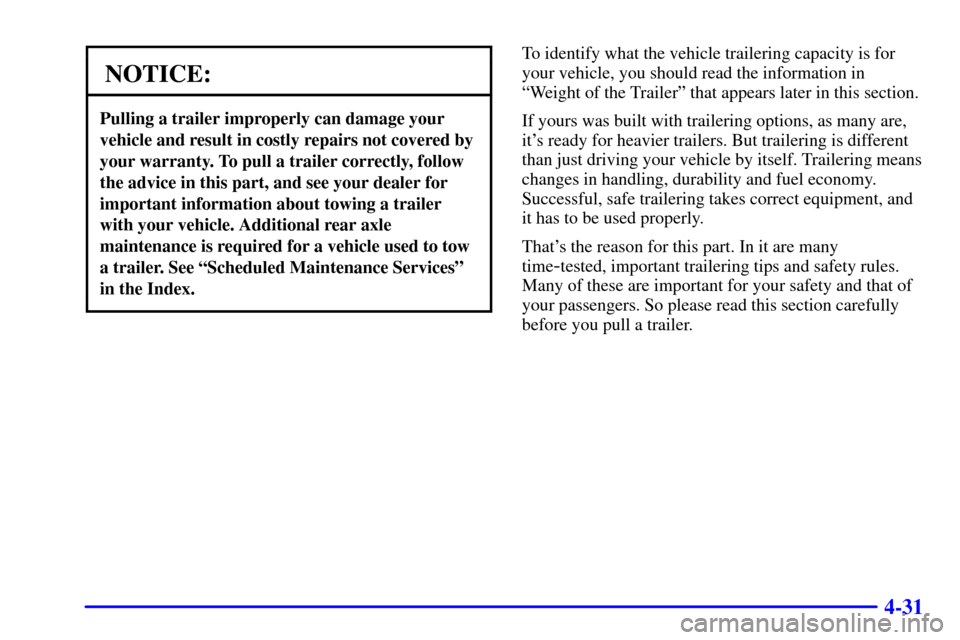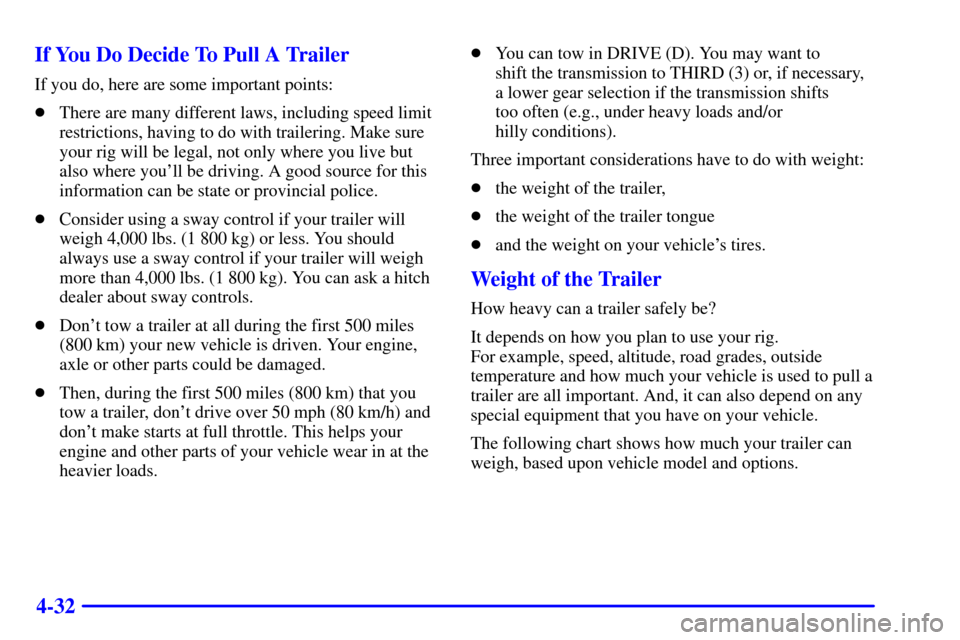Page 190 of 411
4-
4-1
Section 4 Your Driving and the Road
Here you'll find information about driving on different kinds of roads and in varying weather conditions.
We've also included many other useful tips on driving.
4
-2 Defensive Driving
4
-3 Drunken Driving
4
-6 Control of a Vehicle
4
-6 Braking
4
-9 Steering
4
-11 Off-Road Recovery
4
-12 Passing
4
-13 Loss of Control
4
-14 Driving at Night
4
-16 Driving in Rain and on Wet Roads4
-19 City Driving
4
-20 Freeway Driving
4
-21 Before Leaving on a Long Trip
4
-22 Highway Hypnosis
4
-22 Hill and Mountain Roads
4
-24 Winter Driving
4
-27 Recreational Vehicle Towing
4
-28 Loading Your Vehicle
4
-30 Towing a Trailer
Page 219 of 411

4-30 Trailering Package
If your vehicle is equipped with the trailering package,
there is also a load rating which includes the weight of
the vehicle and the trailer it tows. This rating is called
the Gross Combination Weight Rating (GCWR).
When you weigh your trailer, be sure to include the
weight of everything you put in it. And, remember to
figure the weight of the people inside the vehicle as part
of your load.
Your dealer can help you determine your GCWR.
Add-On Equipment
When you carry removable items, you may need to put a
limit on how many people you carry inside your vehicle.
Be sure to weigh your vehicle before you buy and install
the new equipment.
Towing a Trailer
CAUTION:
If you don't use the correct equipment and drive
properly, you can lose control when you pull a
trailer. For example, if the trailer is too heavy, the
brakes may not work well
-- or even at all. You
and your passengers could be seriously injured.
Pull a trailer only if you have followed all the
steps in this section. Ask your dealer for advice
and information about towing a trailer with
your vehicle.
Page 220 of 411

4-31
NOTICE:
Pulling a trailer improperly can damage your
vehicle and result in costly repairs not covered by
your warranty. To pull a trailer correctly, follow
the advice in this part, and see your dealer for
important information about towing a trailer
with your vehicle. Additional rear axle
maintenance is required for a vehicle used to tow
a trailer. See ªScheduled Maintenance Servicesº
in the Index.
To identify what the vehicle trailering capacity is for
your vehicle, you should read the information in
ªWeight of the Trailerº that appears later in this section.
If yours was built with trailering options, as many are,
it's ready for heavier trailers. But trailering is different
than just driving your vehicle by itself. Trailering means
changes in handling, durability and fuel economy.
Successful, safe trailering takes correct equipment, and
it has to be used properly.
That's the reason for this part. In it are many
time
-tested, important trailering tips and safety rules.
Many of these are important for your safety and that of
your passengers. So please read this section carefully
before you pull a trailer.
Page 221 of 411

4-32 If You Do Decide To Pull A Trailer
If you do, here are some important points:
�There are many different laws, including speed limit
restrictions, having to do with trailering. Make sure
your rig will be legal, not only where you live but
also where you'll be driving. A good source for this
information can be state or provincial police.
�Consider using a sway control if your trailer will
weigh 4,000 lbs. (1 800 kg) or less. You should
always use a sway control if your trailer will weigh
more than 4,000 lbs. (1 800 kg). You can ask a hitch
dealer about sway controls.
�Don't tow a trailer at all during the first 500 miles
(800 km) your new vehicle is driven. Your engine,
axle or other parts could be damaged.
�Then, during the first 500 miles (800 km) that you
tow a trailer, don't drive over 50 mph (80 km/h) and
don't make starts at full throttle. This helps your
engine and other parts of your vehicle wear in at the
heavier loads.�You can tow in DRIVE (D). You may want to
shift the transmission to THIRD (3) or, if necessary,
a lower gear selection if the transmission shifts
too often (e.g., under heavy loads and/or
hilly conditions).
Three important considerations have to do with weight:
�the weight of the trailer,
�the weight of the trailer tongue
�and the weight on your vehicle's tires.
Weight of the Trailer
How heavy can a trailer safely be?
It depends on how you plan to use your rig.
For example, speed, altitude, road grades, outside
temperature and how much your vehicle is used to pull a
trailer are all important. And, it can also depend on any
special equipment that you have on your vehicle.
The following chart shows how much your trailer can
weigh, based upon vehicle model and options.
Page 222 of 411
4-33
Model Engine Axle Ratio Max. Trailer Weight (lbs.) (kg) GCWR (lbs.) (kg)
G1500 (Cargo) 4.3L 3.42 4,600 (2088) 9,500 (4313)
5.0L 3.42 5,600 (2542) 10,500 (4767)
5.7L 3.42 6,100 (2769) 11,000 (4994)
G1500 (Passenger) 4.3L 3.42 4,200 (1907) 9,500 (4313)
3.73 4,700 (2134) 10,000 (4540)
5.0L 3.42 5,100 (2315) 10,500 (4767)
5.7L 3.42 5,600 (2542) 11,000 (4994)
3.73 6,600 (2996) 12,000 (5448)
G2500 (Cargo) 4.3L 3.42 4,300 (1952) 9,500 (4313)
4.10 5,000 (1816) 10,500 (4767)
5.0L 3.42 5,200 (2361) 10,500 (4767)
5.7L 3.42 5,700 (2588) 11,000 (4994)
3.73 6,400 (2906) 12,000 (5448)
4.10 7,900 (3587) 13,500 (6129)
6.5L 3.73 8,500 (3859) 14,500 (6583)
4.10 8,500 (3859) 14,500 (6583)
Page 223 of 411
4-34
Model Engine Axle Ratio Max. Trailer Weight (lbs.) (kg) GCWR (lbs.) (kg)
G2500 (Passenger) 5.7L 3.73 5,800 (2633) 12,000 (5448)
4.10 7,300 (3314) 13,500 (6129)
6.5L 3.73 8,100 (3677) 14,500 (6583)
4.10 8,100 (3677) 14,500 (6583)
G3500 (Cargo) 5.7L 3.73 6,300 (2860) 12,000 (5448)
4.10 7,800 (3541) 13,500 (6129)
6.5L 3.73 8,400 (3814) 14,500 (6583)
4.10 8,400 (3814) 14,500 (6583)
8.1L 3.42 7,500 (3405) 13,500 (6129)
3.73 9,000 (4086) 15,000 (6810)
4.10 10,000 (4540) 17,000 (7718)
G3500 (Passenger) 5.7L 3.73 5,600 (2542) 12,000 (5448)
4.10 7,100 (3223) 13,500 (6129)
6.5L 3.73 7,800 (3541) 14,500 (6583)
4.10 7,800 (3541) 14,500 (6583)
8.1L 3.42 6,800 (3087) 13,500 (6129)
3.73 8,300 (3768) 15,000 (6810)
4.10 10,000 (4540) 17,000 (7718)
Page 224 of 411

4-35
Maximum trailer weight is calculated assuming the
driver and one passenger are in the towing vehicle and
it has all the required trailering equipment. The weight
of additional equipment, passengers and cargo in the
towing vehicle must be subtracted from the above
maximum trailer weights.
You can ask your dealer for our trailering information or
advice, or you can write us at the address listed in your
Warranty and Owner Assistance Information Booklet.
In Canada, write to:
General Motors of Canada Limited
Customer Communication Centre, 163
-005
1908 Colonel Sam Drive
Oshawa, Ontario L1H 8P7
Weight of the Trailer Tongue
The tongue load (A) of any trailer is an important
weight to measure because it affects the total or gross
weight of your vehicle. The Gross Vehicle Weight
(GVW) includes the curb weight of the vehicle, any
cargo you may carry in it, and the people who will be
riding in the vehicle. And if you will tow a trailer, you
must add the tongue load to the GVW because your
vehicle will be carrying that weight, too. See ªLoading
Your Vehicleº in the Index for more information about
your vehicle's maximum load capacity.
If you're using a weight-carrying or a
weight
-distributing hitch, the trailer tongue weight (A)
should be 10 percent to 15 percent of the total loaded
trailer weight (B). Do not exceed the maximum
allowable tongue weight for your vehicle.
After you've loaded your trailer, weigh the trailer and
then the tongue, separately, to see if the weights are
proper. If they aren't, you may be able to get them right
simply by moving some items around in the trailer.
Page 225 of 411

4-36 Total Weight on Your Vehicle's Tires
Be sure your vehicle's tires are inflated to the upper
limit for cold tires. You'll find these numbers on the
Certification label at the rear edge of the driver's door or
see ªLoading Your Vehicleº in the Index. Then be sure
you don't go over the GVW limit for your vehicle,
including the weight of the trailer tongue.
Hitches
It's important to have the correct hitch equipment.
Crosswinds, large trucks going by and rough roads are
a few reasons why you'll need the right hitch. Here are
some rules to follow:
�The bumpers on your vehicle are not intended
for hitches. Do not attach rental hitches or other
bumper
-type hitches to them. Use only a
frame
-mounted hitch that does not attach to the
bumper. Do not use a ball hitch, because it could
pull the bumper loose.�If you'll be pulling a trailer that, when loaded, will
weigh more than 4,000 lbs. (1 800 kg), be sure to
use a properly mounted, weight
-distributing hitch
and sway control of the proper size. This equipment
is very important for proper vehicle loading and
good handling when you're driving.
�Will you have to make any holes in the body of your
vehicle when you install a trailer hitch?
If you're using the wiring provided by the
factory
-installed hitch, you should not need to make
any holes in the body of your vehicle. However, if
you have an aftermarket hitch installed, you may
need to make holes in the body.
If you do, then be sure to seal the holes later when
you remove the hitch. If you don't seal them, deadly
carbon monoxide (CO) from your exhaust can get
into your vehicle. See ªCarbon Monoxideº in the
Index. Dirt and water can, too.